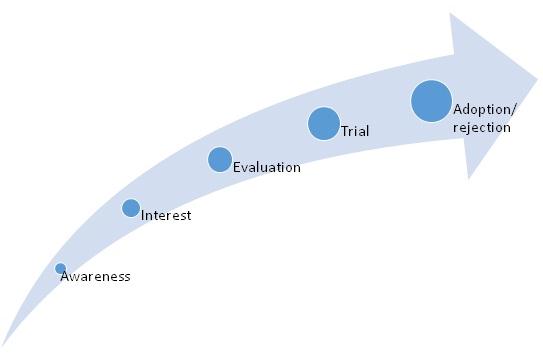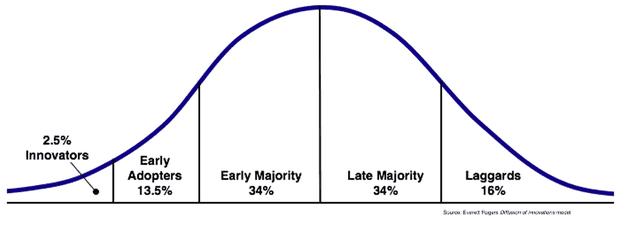The diffusion of innovation is the rate at which a product gets diffused in the market or society.
We find the adoption curve of a new product launched by a company.
Suppose you have your own company and you have launched a product in the market. You can track the consumer adoption process.
Are you excited to know how?
Let us see.
First, we will understand how the product is adopted. Then we will see how the product diffusion takes place.
What is in it for me?
Product Adoption Definition
Product adoption means a consumer decides to adopt or buy your product for his or her personal use. He finally decides to consume your product.
The product life cycle depends on how the product is getting consumed by the customers. The faster the product gets absorbed, the faster product reaches its maturity stage.
After the maturity stage, then the product starts entering the declining phase.
Hence, we need to observe the process of product adoption and diffusion process. It will help us to form the product life cycle stage.
Concept of Product Adoption
The concept of product adoption is concerned with new products. People will only buy your product seeing the benefit or the utilities they are deriving from it.
So let us try to understand the methods of developing a product. It will only decide the pace of adoption of your product.

Innovation
It means you develop a new product that does not exist in the market to date. Now, these kinds of products have a high chance that they will get consumed by the people.
But it also depends on the benefit the customers get from your goods or service. If they are satisfied with the product, then the adoption process will be speedy.
To come up with an innovative product, you need to be very good at research and development. It gives you insight and data about the market. Then only you can develop and launch a unique product.
Modifications
In this method of product development, you change the existing goods or services. Now with new quality, you launch the product in the market.
These kinds of products also have the chance of fast adoption process. But the adoption process pace is less as compared to the innovative product.
There are various ways to change your product.
a. Quality modification
b. Functional modification
c. Style modification
d. Packaging modification
e. Price modification
These are some ways where you can change the existing product of your competitors. It will give you an extra benefit.
Me Too Products
In this, you launch the same kind of product in the market which already exists. You do not go for any modification process.
It has a very low or no chance to get adopted by the consumers in the market.
Why?
It is because there are competitors already sitting in the market. They have captured the market and have a significant market share.
Those companies already have their loyal customers. So, it becomes challenging to survive in such a market, and you have to take the back seat.
Hence, it is advisable not to go for such kind of product.

Product Adoption Process
There is a process of how the consumer starts adopting the product. It is a mental process that a consumer goes through before buying the product.
It starts by gathering information about the products available in the market. Finally, it ends up deciding to buy that product and become its regular consumer.
There are five steps in the product adoption process. Let us study them one-by-one.
- Awareness – The first step a consumer takes is to get aware of the product. They collect information about arrived products.
- Interest – Next stage is where the consumer generates excitement for your product. After they know about the product, they think of buying it.
- Evaluation – After building interest in your product, consumers check it. They check all the features and all. Then only they go for making a buying decision.
- Trial – Next is the trial stage where consumers try the product before purchasing it. They use the product and check whether it is good or not.
- Adoption – Final stage is the adoption stage. Here, after getting satisfied, the consumer finally decides to buy. So this is where the product adoption process ends.
Diffusion of Innovation
The diffusion of innovation means in which rate the product is diffusing in the market. Product diffusion is also known as the diffusion of innovation.
The product gets adopted by the people only when they come to know about it. So it is vital to communicate with your customers to aware them about your goods or service.
There are different types of people living in our society. They have their views.
Some of their rate of adopting new product is very high. There are some others whose adoption rate is meager.
Hence, you have to plan your marketing as per the types of consumers found in the market. So, you have to study the characteristics of different consumers.
Marketing products is a vital function. Through this, only you make people aware of your product.
There are various ways to promote your goods or service. Some of them are like word-of-mouth, sales promotion, personal selling, etc.
Different consumers adopt products at different rates. We can divide them into five categories.
Diffusion of Innovation Curve
The diffusion of innovation curve represents different types of product adopters. It is also known as the product diffusion curve. As I mentioned earlier, there are five types of product adopters in the market.
Let us study each of them in detail.

Let us study each of them in detail.
Innovators
They are the ones who are ready to take the risk of trying unproven products. They use the product when it is in the research and development stage in the Product Life Cycle.
Innovators are the ones who are well educated, sound, stable, and are ready to take risks. The innovators represent 2.5% of the consumers and are first in the diffusion of innovation curve.
Companies consider them vital as they are the first consumers of the product. But they do not take an active part in spreading the word for the product. They are not very influential.
Early Adopters
Based on the opinion of the innovators, the early adopters then starts giving reaction to the product. If the view is positive, then they start buying it.
Adopters categories represent 13.5% of the consumer and come second in the diffusion of the innovation curve. They take an active part in spreading the word and influencing people to use the product.
Hence, they act as a promoter. In research, it is found that people get more convinced by the reviews of other users than the advertisements.
So, marketers try to focus more on this category of consumers to convince them and make them use it. Then they will influence people further. Thus, early adopters marketing is vital.
They are known as educated opinion leaders. They consume the product when it is in the introduction stage of the Product Life Cycle.
Early Majority
They are the ones who consume the product after getting the opinion of early adopters. This category represents 34% of the consumer. They come in third place in the diffusion of innovation curve.
They do not take the risk. Hence, the early majority buy the product after getting convinced. Also, when proved by the innovators and early adopters.
The marketers target them because they consist of the majority of the total consumer. Hence, the consumption of products by them will decide the success and failure of the product.
So, it is vital to convincing this group to succeed and capture the vast market. The early majority consumes the product when it is at the growth stage in the Product Life Cycle.
Late Majority
These are the consumers who are not at all ready to take the risk. They consume the product only when it has become common. The craze for it has gone.
They are quite like the early majority. The late majority represents 34% of the consumer. They get placed at fourth in the diffusion of innovation curve.
They consume the product when it is at its maturity stage in the Product Life Cycle. It is because many competitors enter the market, providing the same product.
Now here starts the price competition among the companies. Hence, the price starts falling. So it might happen that they found the cost of the product very high earlier, but now it is affordable.
Laggards
They are the ones who avoid changes. They are not ready to adopt the product until it gets outdated, and it is no more in demand.
These types of consumers support traditional things more. Hence, they comprise of old age people.
Laggards represent 16% of the consumer and are the last one in the diffusion of innovation curve. They consume the product when it is at its declining stage.
Factors of Diffusion of Innovation Rate
The diffusion of innovation rate depends on many factors. They are as follows:
- Benefits over existing or alternative products
- Communication about the product to consumers
- Price and its on-going cost in the market
- Ease of using
- Promotional activities and efforts
- Distribution system or facility
- Perceived risk

Conclusion
By now, you must have understood what diffusion of innovation theory is. The diffusion of innovation theory is essential for every company. It tells you how and to which rate your product diffuses in the society.
Thus, you get to know how your target market reacts to your product. Also, at what rate they are adopting your product and what the areas you need to improve.
There are many other aspects as well that I have covered. I have narrated you in the process of how people adopt any product instead of direct jumping into the topic.
Also, I tried explaining them in simple language and in detail. So, I hope you liked it and understood everything about this concept.
FAQs
The diffusion of innovation theory is a study of how a product is getting diffused in a society.
E. M. Rogers discovered the Diffusion of Innovation theory in 1962. It is one of the oldest social science theories. Hence, it is also known as the Rogers Diffusion of Innovation Theory.
Diffusion of innovation is critical because you come to know about the following:
1. Rate of spread of the product in society
2. Which type of customer to target first
3. Target market
4. Improvement in the product if any
5. Nature of the customers
I have explained this in detail. You can have a look in the above sections. This whole blog is all about it. I hope you understand all the subtopics.



